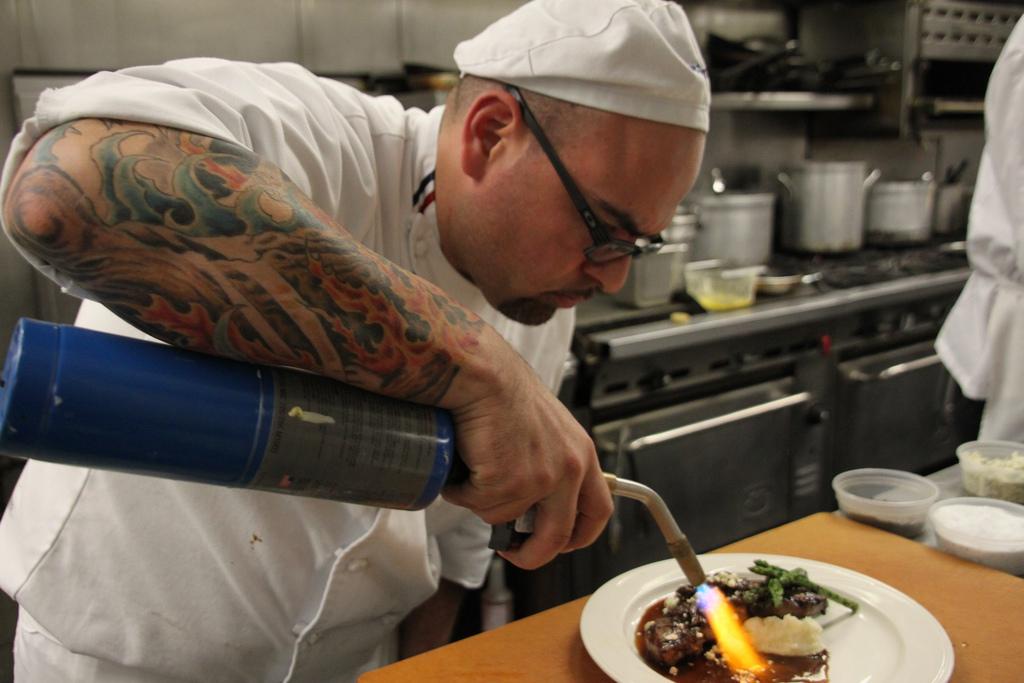“Hot! Hot!” a student chef yells in warning, running across the kitchen with a tray of steaming potatoes.
It’s 10 a.m. on a Tuesday morning and many of the students in the kitchen behind the Norseman restaurant have been cleaning, dicing and sautéing since 6:30 a.m. Right now, they are preparing for the daily “plate-up,” where they will present the menu to the serving staff of the Norseman.
While most students spend their weekdays taking history notes or studying statistics, the students in DVC’s culinary program are preparing dish after dish of roast beet ravioli and New York steak with porcini sauce and gorgonzola.
The menu for the restaurant changes weekly, explains culinary arts student Juan Hernandez. Each student in the class is in charge of creating a menu, which usually follows a certain theme, such as food from a certain geographic area.
This week, it’s an Italian menu, with dishes like chicken piccatta, shrimp scampi and bruschetta toast topped with prosciutto, aioli, and a green olive-red pepper relish.
The desserts also change every week, and like the main courses, it’s up to the students to plan the menu.
This morning, baking student Kacy Studeman is executing a plan for her designated dessert choice: gingerbread shortcakes with caramelized apples and cider sabayon.
“I wanted to use pears,” she says, laughing, “but I’m allergic!”
Studeman already works in a professional restaurant kitchen, and like other students in the program, hopes to continue her dream of working in the food industry.
The college’s culinary program is divided into three different areas of study: baking and pastry, culinary arts and restaurant management. All of these programs offer classes that contribute to the running of the Norseman, thus giving students a glimpse into the professional culinary world.
“In the morning, sometimes we’ll have a lecture or demo,” says culinary instructor Brian McGlynn. “But it’s very hands-on.”
Students are expected to rotate with every chore so they can learn as many aspects of the business as possible. This, explains McGlynn, makes a chef more valuable in the industry.
The expectation for well roundedness is apparent also in the scope of classes each culinary student takes.
Baking students must take fundamental cooking classes, and culinary arts students take classes in catering and dining room operations, where they take orders, serve food, wash dishes and act as cashiers for the Express Bar — where customers can get take-away orders.
Today, there is laughter, a few sighs and one or two groans of mild complaint in the front of the house as instructor Claude Capozzo assigns students daily duties for the week.
“Sorry about that,” Capozzo says as he hands out a dishwashing assignment.
It’s now 11 a.m., and the doors to the Norseman have opened, allowing inside a flood of hungry students who flock to the Express Bar line, and a few others, mostly instructors, who wander to the sit-down side of the restaurant.
The restaurant closes its doors at 1 p.m., at which time the students will clean up and prepare to start all over the next day.
Having been at the department for more than 20 years, baking instructor Chris Draa says the students’ long hours create a unique experience because he is able to develop such a close relationship with them.
“At the beginning, they’re punks — they’re completely lost,” he says of many students starting the program. “It’s nice to see the students mature. We get to know our students more than most teachers ever would.”
Draa urges students to gain some experience in some aspect of the restaurant business before deciding to pursue a certificate from the culinary program, noting that the rigorous Monday–Thursday schedule can be overwhelming for unprepared students.
“It’s very similar to working in the industry,” he says of the experiential learning in the program.
In fact, Draa’s office hours begin at 6 a.m., since for most of his students, class time will extend from 7 a.m. to 1 p.m.
He points to the flurry of movement outside his office in the corner of the kitchen behind the DVC bake shop, where baking students prepare and then sell a variety of muffins, cookies, pastries and cakes. There are pans of brioches and some students are gushing over the still-warm morning buns.
“This is not like T.V.,” Draa says.
Contact Annie Sciacca at [email protected]





































































